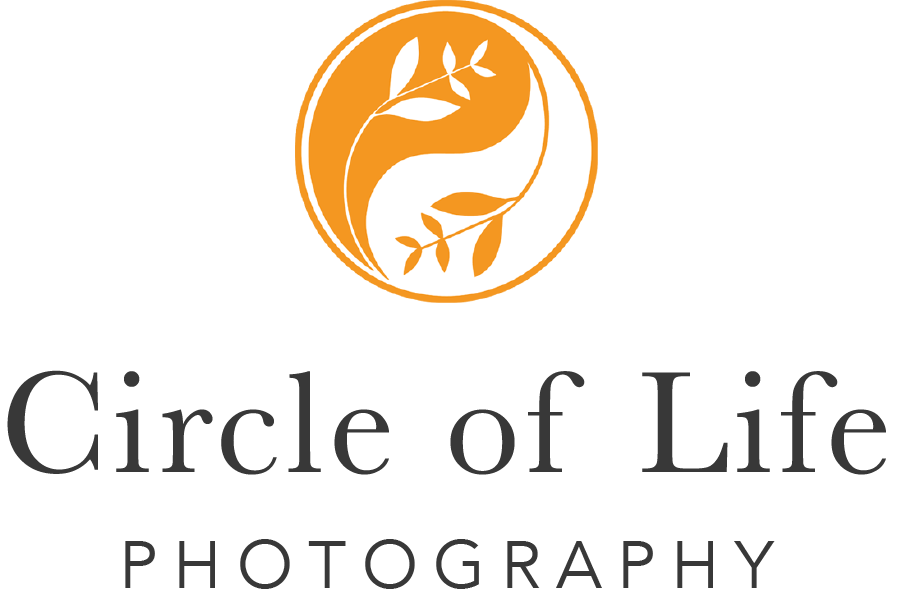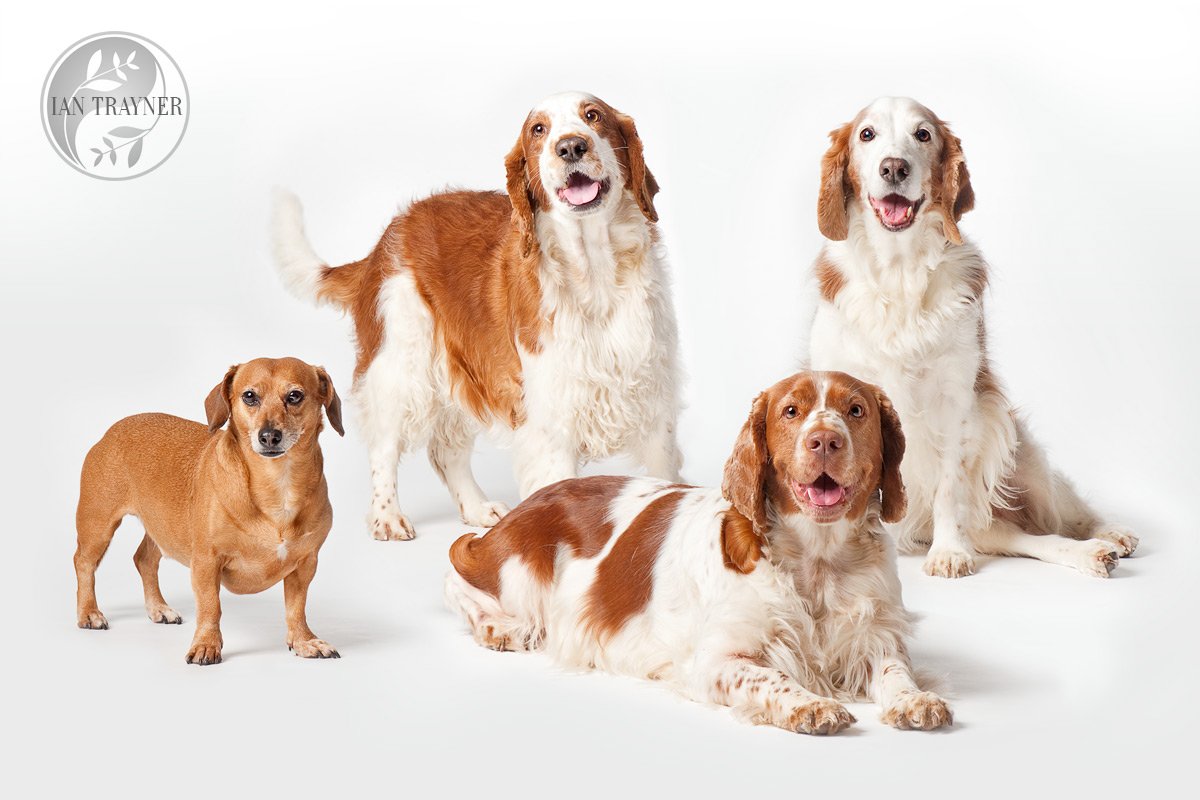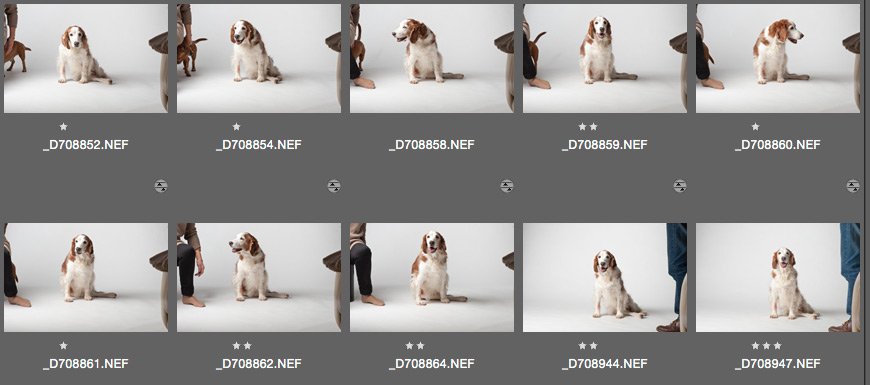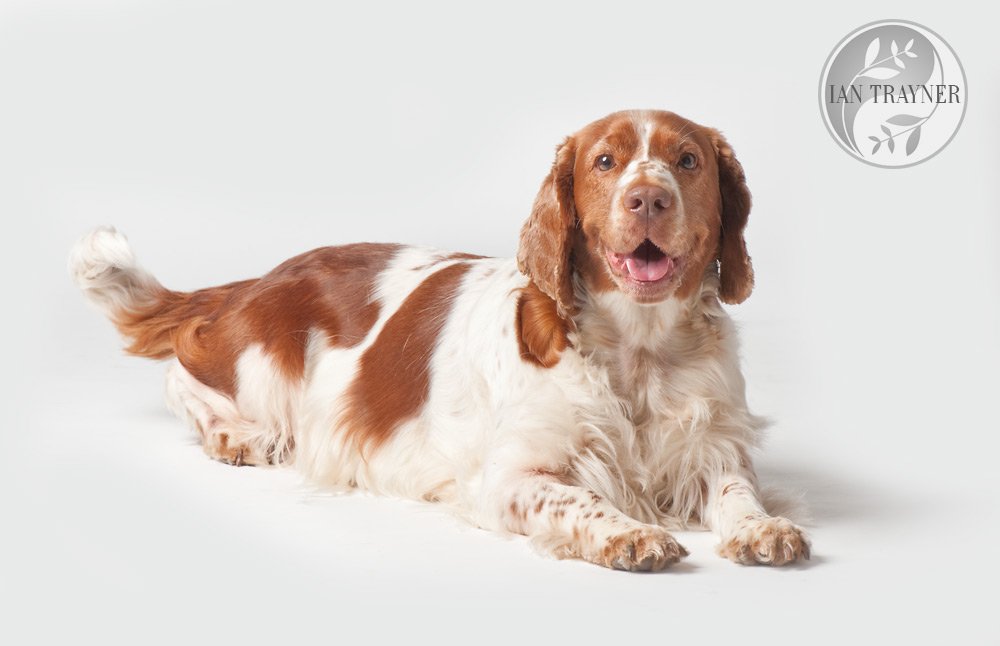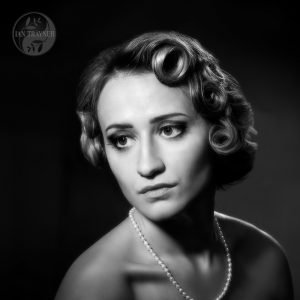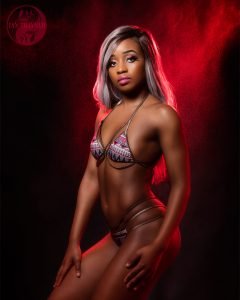Dog photography in my studio in Kingston
Dog photography is one of my favourite things. I photograph dogs in my studio, and also on location. Running, playing, or just being in a natural environment. I will even mix sessions so you can have some time in the studio and some time on location. However if we are going to mix photography in the studio with shooting on location, we will always start in the studio. That is to say, with a clean dog!
Check out the pet and dog photography gallery on my website for some samples.
How can I photograph a dog in a good pose?
That is potentially a problem. Although it does depend a lot on the dog, and the relationship between the dog and it’s owner.
Now if you have four dogs, the problem is raised to the power of four!
Or is it?
The solution is…
The solution is to make a composite image.
From the moment this potential client first told me on the phone that she wanted a photograph of four dogs all together, so she could have a large picture of them to hang on her wall, I knew I was going to take four photographs – one of each dog – and put them together in a composite image. But it is important you plan ahead, and do this the right way. Because it is possible to make life difficult for yourself if you don’t remember a few good principles.
Photographing dog number 1
“Tilley” is elderly in these photos. She tends to hang her head. And like most dogs, she doesn’t find a camera particularly interesting so she is more likely to look anywhere else. Most dogs tend to look toward their owner (or handler) for guidance. Well, I am guessing it is for guidance. It may be for guidance, or reassurance, or “am I allowed to do this?” So if you want a dog to look towards the camera, it can help to bring the owner close to the camera. But only works if the dog is really well trained to stay put – otherwise the dog will probably just walk up to the camera!
So it is partly a matter of being patient, trying to catch the dog’s attention, and taking photos until you capture some good candidates. It usually doesn’t take very long.
Here are some of the photos I took of Tilley. File file number 8947 is the one I decided to use.
Photogaphing dog number 2
Same problem. The dog is interested in everything but the camera.
Of course I have a few squeeky toys. But these usually only attract the dog’s attention for a few moments. So you have to have your hand ready on the shutter.
Image 9036 is the best for my purposes.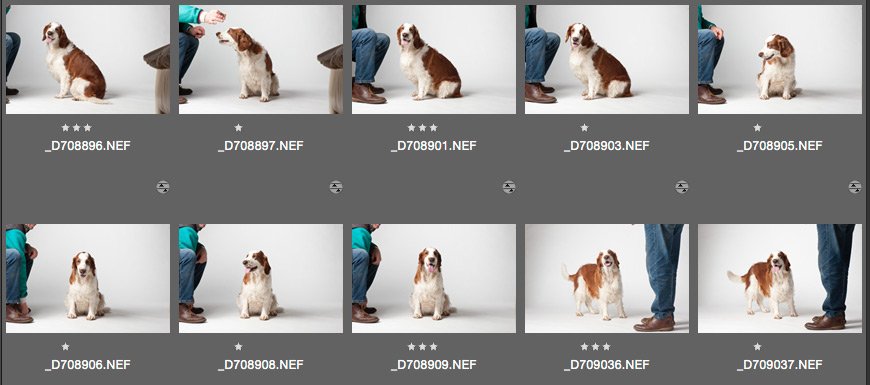
Photographing dog number 3
Dog number 3 was the most energetic of the spaniels. But I wanted to have this dog lying down so I could compose a more pleasing group photo. I did not want all the dogs to be in the same pose – I was aiming for some variety. It was also necessary that all four dogs could be fitted in close to each other without wasting space in the final image. Therefore it seemed a good idea to have this dog lying down in front of the other dogs. Overlapping but not obscuring.
Not rolling on your back though! Silly dog! There are a number of interesting shots here. But my client has a very specific agenda – she wants to buy one picture for the wall that includes all four dogs.
So image 9068 is the one I will use. Notice how I have brought this dog further forward on the studio floor – ie closer to the camera than the other dogs. Thus the camera will be “looking down at” this dog more, in comparison to the other dogs.
Because I have kept the camera in the same place, with all the same settings, this dog will appear to be naturally in front of the first two dogs in the final composite image. I am also using a very deep depth of field so all dogs are sharply in focus, even though some are significantly closer to the camera than others.
Photographing dog number 4
Not a spaniel this time.
It is important when photographing several animals for a group composite photo that the image as a whole looks consistent. Therefore I shot with the camera on a tripod. I was using a zoom lens but I did not change the focal length of the lens throughout all the photos. That means dog number 4 is smaller in the frame than the other dogs. He is also the smallest dog. But I resist the temptation to zoom in on him. I want all four dogs to be located in their own positions in the final shot. I also want them to be the correct size relative to each other. For this reason also I leave the camera in the same place, at the same focal length for all the photographs.
I am using a relatively small aperture so I have a deep depth of field. So once again, the final photo will look consistant across all four dogs. Image 8993 is the one I selected for the final composite image.
So here are the four final images in their “before” and “after” states
Now it is just a question of stitching the photos together. Each dog has his or her own layer in Photoshop. It is also necessary to make some masks (this is not the place to describe any of this).
Here are the four individual dog photographs
You just gotta love them! I am sure no dog lover can look at these images without smiling!

And here is the final composite image
I had to make some masks so I could place the lying down dog in front of the other dogs. Making masks is usually the most time consuming part of making composite images.
Would you like to book your own dog photography session?
There are links on my website describing how to book a photo shoot, and other stuff like terms and conditions. I book dog photography sessions just like other photography sessions.
I can photograph your dog, or dogs, in my studio or on location if you prefer actions shots. We can even mix the two together.
If you are bringing your dog to my studio for a photo shoot, please make sure the dog(s) are clean! If it is raining we can dry their paws when they come indoors. There are no parking restrictions in my road, so with luck you won’t have far to walk from your car to my door.
My recommendations for composite dog photography
If you are a photographer and want to try your hand at composites like this one, it helps to bear a few simple principles in mind to make your life easier;
- I recommend making sure every dog is photographed in the spot (on the floor) in which s/he will be in the final composite image. Thus the relationship of the camera to each dog is consistent for all the animals. It makes your life easier if a dog “on the back row” is photographed “on the back row”. You might be tempted to take large photos of each dog and stitch them together in Photoshop. And you could do that (especially if you hope to sell individual photos of the dogs). But if you do this, you will have to estimate how large each dog should be in the final image! You might get it wrong, and the owner will notice. If you place each dog “on his/her own spot” for the photography, you won’t have this problem. Because the size of each dog will have been captured correctly in camera.
Thus, in this example, the spaniel lying down is at the front. I shot him in that position, nearest to the camera. The two spaniels further back were further back on the floor.
Working this way also guarantees that the shadows look consistent for every dog, because they are all being lit by the same lights. - Use exactly the same lighting and camera settings for every photo. Choose an aperture that allows a deep depth of field, so every dog is sharp no matter where s/he is located on the floor. In this example I was shooting at F14 using a full frame camera.
- A plain background definitely makes your job easier when it comes to stitching the photos together.
Shooting a white subject against a white background
When shooting a white subject against a white background it is important to get your exposure correct. It is essential that you avoid overexposure, because this bleaches out all the detail in the highlights. For example, you need to see the texture of the dogs’ hair. It helps if you have some black sheets or boards to the sides of your subject. This reduces the light falling on the sides of the dogs.
Post production
To make the composite, first you need to edit all the images so they are totally consistent with each other. In this example the background has to be the same shade of white. Contrast, saturation and colour balance (etc) are all consistent.
You will need to put each dog on his or her own layer in Photoshop. Masks need to be made where their bodies overlap in the final composite image.
The wee brown dog
The wee brown dog adds a quirky “something”. And he is after all an equal member of the family!
